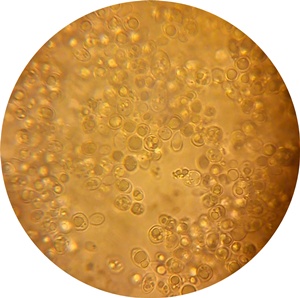LAB 2: MEASUREMENT AND COUNTING OF CELLS USING
MICROSCOPE
2.1 Ocular Micrometer
Introduction
Ocular micrometer
is use in order to measure and compare the size of prokaryotic and eukaryotic
microorganism. Microorganisms are measured with an ocular micrometer which is
inserted into the one of the microscope eyepieces. The micrometer, which serves
as a scale or rule, is a flat circle of glass upon which are etched equally
spaced divisions. This is not calibrated, and may be used at several
magnifications. When placed in the eyepieces, the line superimposed certain
distance markers on the microscope field. The actual distance superimposed may
be calibrated using a stage micrometer on which parallel lines exactly 10 µm
apart etched. By determining how many units of the ocular micrometer
superimpose a known distance on the stage micrometer, you can calculate the
exact distance each ocular each ocular division measures on the microscopic
field. When you change objectives you must recalibrate the system. After
calibration of ocular micrometer, the stage micrometer is replaced with a slide
containing microorganism. The dimensions of the cells may then be determined.
Objective
To measure and count cells using microscope
Results
1)
Lactobacillus
40 x
magnifications
100 x
magnifications
2)
Yeast
40 x
magnifications
100 x
magnifications
Discussion
To compare and measure the size
of prokaryotic and eukaryotic microorganisms, we used ocular micrometer. We use
the lowest power objective to focus the microscope until the image on the stage
micrometer is superimposed on the eyepiece scale and calibrate.
Prokaryotic and eukaryotic has
different characteristic. Prokaryotic cell is a single cell while eukaryotic cell
is more complex than prokaryotic and can be single or multicellular cell. Prokaryotic cell has smaller size
because prokaryotic does not contain many organelles compared to eukaryotic
such as chloroplast, nucleus, endoplasmic reticulum and cell membrane.
The example of prokaryotic cell
in this experiment is lactobacillus and yeast as the example of eukaryotic. During
the experiment, we used 40x
magnification and 100x magnification to observe the both cells.
As the conclusion, we are able to learn on measuring and counting the cells using microscope. An ocular micrometer is a glass disk that attaches to a microscope’s eyepiece. An ocular micrometer has a ruler; calibrated with a slide micrometer that allows the user to measure the size of magnified objects. The distance between the marks on the ruler depends upon the degree of magnification. We used this ocular micrometer to observe prokaryotic and eukaryotic cells since these two cells are very small.
400x magnification
|
1000x magnification
| |||
calibrate
|
Stage micrometer
|
Ocular division
|
Stage micrometer
|
Ocular divison
|
0.03 mm
|
38 division
|
0.09 mm
|
96 division
| |
7.9x10⁻⁴ mm
|
1 division
|
9.38x10⁻⁴ mm
|
1 division
| |
0.79 µm
|
1 division
|
0.94 µm
|
1 division
| |
Size of microorganism : 2 division 5 division
YEAST :
400x magnification
4 division x 0.79 µm
=3.16 µm
1000x magnification
7 division x 0.94 µm
= 6.58 µm
LACTOBACILLUS :
400x magnification
2 division x 0.79 µm
=1.58 µm
1000x magnification
5 division x 0.94 µm
=4.7 µm
Conclusion
Conclusion
As the conclusion, we are able to learn on measuring and counting the cells using microscope. An ocular micrometer is a glass disk that attaches to a microscope’s eyepiece. An ocular micrometer has a ruler; calibrated with a slide micrometer that allows the user to measure the size of magnified objects. The distance between the marks on the ruler depends upon the degree of magnification. We used this ocular micrometer to observe prokaryotic and eukaryotic cells since these two cells are very small.
Reference
http://www.ehow.com/how_5019336_use-ocular-micrometer.html
Pearson International edition Biology 8th Edition, Campbell. Reece
In the second experiment, Neubauer chambers are used for more accurate in counting microbes. In addition, the sterilization method is used to avoid contamination of microorganism. The types of sterilization that we used is flame sterilization and also Pasteur pipette to transfer the yeast to the slide.
1. Pearson International Edition Biology, 8th Edition, Campbell, Reece
2.2 Neubauer Chamber
Introduction
Neubauer chambers are more convenient
for counting microbes. The Neubauer is a heavy glass slide with two counting
areas separated by a H-shaped trough (see figure 2.1). A special coverslip is
placed over the counting areas and sits a precise distance above them.
Objective
To count cells using
microscopes.
Result
Discussion
In the second experiment, Neubauer chambers are used for more accurate in counting microbes. In addition, the sterilization method is used to avoid contamination of microorganism. The types of sterilization that we used is flame sterilization and also Pasteur pipette to transfer the yeast to the slide.
The chamber consists of 9 major large squares. In the
calculation, we only use the middle of the large square. Inside the large square, there contain another
16 smaller squares. Then choose 10 squares out of 16 squares to calculate the
number of yeast.
56 ÷ 10 = 5.6
= 6
Volume = 0.05 x 0.05 x 0.01 mm
= 2.5 x 10⁻⁵ mm
= 2.5 x 10⁻⁷ ml
6 cells in 16 squares
1 square = 6 ÷16
= 0.375 cells in 2.5 x 10⁻⁷ ml
1ml = 0.375 ÷ 2.5 x 10⁻⁷
= 1500000 cells/ml
Conclusion
As the conclusion, we can use two methods to measure and
count cells using methods. The first one is by using ocular micrometer and the second
one by using Neubauer chambers. By using Neubauer chambers, we can get more convenient
in counting the cells compared to ocular micrometer. This is because, when
using Neubauer chambers, the sterilization is needed to avoid any contaminant. Hence, Neubauer chambers are suitable to count the
cells.
Reference
1. Pearson International Edition Biology, 8th Edition, Campbell, Reece



























